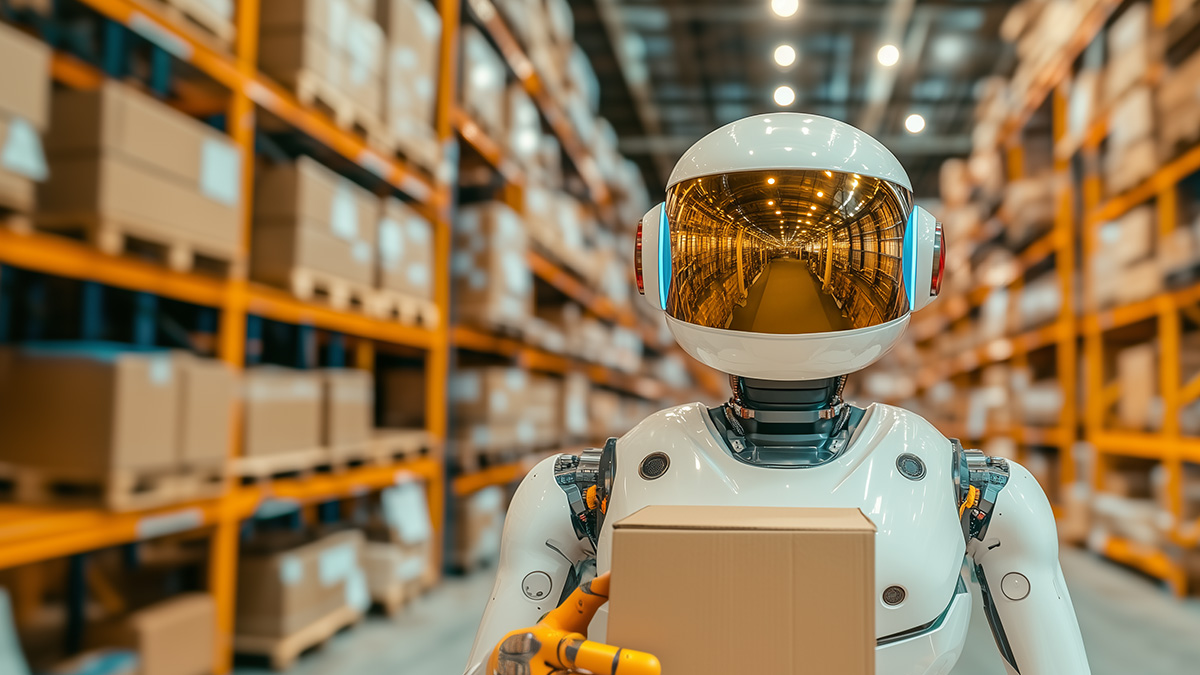Humanoid Robot Mass Adoption Hinges on Affordability and Scale

Consider that just a decade ago (or less) someone would have been thought of as a bold futurist if they spoke of a world where ordinary people regularly used artificial intelligence in their daily routines. If they also suggested that human-looking robots would be fulfilling taxing and tedious physical labor at the warehouse or helping them around the house they would likely have been met with disbelief. As it turns out, the future is now — or certainly, just around the corner.
"The ChatGPT moment for general robotics is just around the corner.” – Jensen Huang, CEO of NVIDIA, at CES 2025
Taking center stage in this latest moment of technological transformation is a new player called a humanoid. Intentionally human looking in appearance, humanoids are advanced robotic machines enabled by sophisticated sensor, optics, and compute technology to perform tasks traditionally performed by humans. To be clear, however, humanoids will not be replacing human workers on the factory floor or elsewhere. Their role is an additive one. By freeing people from arduous, low skill labor, humanoids empower the clever species that created them for higher value activities.
What Can Humanoids Do? Let Robotics Do the Heavy Lifting
Annual surveys of workplace safety consistently rank lifting heavy loads and repetitive motions in their top 10 causes of costly and debilitating injuries. These types of tasks are also precisely the kinds of labor for which humanoids are ideally suited. In industrial applications, like warehouse operations, humanoids are a perfect fit for plugging in the gaps otherwise unmet by existing automated processes.
Humanoids' anthropomorphic design enables them to perform a variety of tasks, from picking and packing to machine tending and inspection. For logistics operators looking to streamline and modify workflows, particularly repetitive ones, humanoids will increasingly be the way to go.
Compared to current automation solutions, which are largely confined machines stuck on digital train tracks, humanoids offer broader task versatility — in a word, agility. Humanoids are also endowed by their creators with autonomy, which means they are not reliant upon larger work site software and operational systems to function, like their cousins, automated guided vehicles (AGVs) and autonomous mobile robots (AMRs).
Robots Building Robots – Jabil and Apptronik Partner Up
In early 2025, Jabil announced a unique collaboration with Apptronik, an Austin-based AI-powered humanoid robotics company, to help scale and accelerate production of its humanoid robot, Apollo. Jabil will function as both a manufacturing partner — building Apollo robots — and a test case, integrating Apollo into specific manufacturing operations on the floor. It's a flywheel in the making where Apollo leans in to help build more of itself.
For Apptronik, Jabil's factory floors provide an ideal real-world validation for testing Apollo's skills with simple, repetitive intralogistics and manufacturing tasks. For Jabil, employees that had previously been handling inspection, sorting, kitting, lineside delivery, fixture placement, and sub-assembly can now be shifted to higher skill level tasks, as well as more creative, thought-intensive work.
In less static environments than a manufacturing facility, like a home or in a healthcare setting, mastering agility is a tall order requiring more than just mechanical competency. Vision and language processing hurdles remain, and crossing these bars requires the harnessing, integration, and scaling of sophisticated optics, sensor, and compute modalities. But make no mistake, humanoids are coming to our homes, and even if they won’t be joining us for dinner, they’ll be terrific at cleaning up after it.
STIQ’s Humanoid Research – A Road Map to the Future
Research indicates that humanoids will be an exceptionally dynamic and fast-to-develop market. Morgan Stanley analysts estimate the market could achieve 8 million humanoids by 2040, while Goldman Sachs’ head of China Industrial Technology research, Jacqueline Du, believes the total addressable market for humanoid robots could reach $38 billion by 2035, up more than sixfold from previous estimates of $6 billion.
These projections are curated within research produced for Jabil by STIQ and are based upon insights from stakeholder interviews the firm conducted with more than five dozen key industry observers and investors.
Featured within STIQ’s report Humanoids 2025 is an insightful guide for understanding humanoid autonomy levels. The simplest, animatronic stage (H1) has figures resembling humans, but without legs, and at the other end (H5), a synthetic human, difficult to differentiate from the real thing. The industry’s current state resides somewhere between levels H1 and H2. Evolution up the scale will require deft balancing of both mechatronics-based workstreams with software development, and in the later stages, capabilities that have yet to be developed.
What Needs to Happen to Deliver on the Promise of Humanoids
Despite the promising potential, several challenges lie ahead for the market to reach the optimistic forecasts. Humanoids at H1 and H2 are already highly complex aggregations of technology and componentry. Reducing manufacturing costs while expanding use cases and accelerating time to market are key.
To meet the current projections for volumes and timelines while broadening functionality towards H5, STIQ asserts will require collaboration across the component supply chain. STIQ estimates that component suppliers will have to invest a minimum of $5 billion to reduce the bill of materials (BOM) to less than $10,000 per robot for a target price point of a $20,000 humanoid.
The return on investment (ROI) for humanoid uses outside industrial automation, what STIQ refers to as “peripheral applications,” hinges on reducing BOM costs. Humanoids need to be relatively cheap with a reasonably high level of functionality specifications to become more than just a novelty purchase. Lower costs, combined with increased functionality and availability, are poised to drive demand and improve the ROI calculation.
Apptronik co-founder and CEO Jeff Cardenas says that, for humanoids to become ubiquitous, “we need to be able to build them rapidly at scale, at the right price point, and in geographies where our customers are located.”
Vertically Integrated Workstreams: A Key Advantage for Building Humanoids
A partner with vertically integrated manufacturing and supply chain capabilities is uniquely positioned to address these challenges and drive the successful integration of humanoid robots into any of the many fields of operation on the horizon, be it the retail warehouse, healthcare setting, or home.
As the humanoid robotics industry expands into broader use cases, partnering with a company that possesses technical prowess, global manufacturing capabilities, and trusted supplier relationships is crucial. Experience in large-scale robotics manufacturing ensures high standards of quality and reliability for humanoid production, while advanced additive manufacturing capabilities reduce lead time and cost.
The best manufacturing partnerships also provide inventory management, design for manufacturing (DfM) expertise, turnkey procurement, and a comprehensive view of a company’s existing supply chain across the entire product lifecycle.
Technology accelerates exponentially which means that changes are coming faster at us than ever before. Soon, we will think of robots in the same way we now think of mobile phones — irreplaceable in our daily lives. But with the help of humanoids, those lives will be less burdened by onerous tasks and chores, freeing us for more stimulating pursuits requiring intelligence and human intuition, ones that people were born to fulfill.
Download "Humanoids 2025"
Explore how humanoid robotics are set to transform our day-to-day lives and gain deeper insights into the future of automation by downloading our comprehensive report produced in collaboration with our research partner STIQ.
This detailed analysis offers valuable information on market trends, technological advancements, and strategic implementations of humanoid robots in a wide range of industries.

